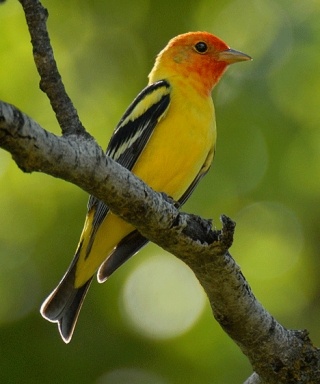On a recent warm afternoon while my husband and I were relaxing on our back patio, a flash of red and yellow flickered through the leaves of a tall alder tree. Bill kept his eye on the bird while I ran inside for binoculars.
With the help of strong afternoon sunlight, we identified the mid-sized songbird as a male Western Tanager. The strawberry-red head, lemon-yellow body and black- and-white wings took our breath away. We agreed it’s the most tropically colored bird found on Whidbey Island.
At first glance the male tanager looked like a large goldfinch. That is until we saw the bright-red head and realized the tanager was a couple inches longer. Unlike the goldfinch that readily comes to our seed feeders, the tanager prefers to forage in the deep shade of conifer and broadleaf deciduous forests. There it feeds on insects, fruit and berries.
A few lucky birdwatchers have been able to lure this bird into their gardens with offerings of fresh-cut oranges or apples.
This beauty is the only tanager species you’ll find in Washington or throughout the western United States. The Scarlet Tanager of the eastern United States is bright red and shiny black. The Summer Tanager of the southern United States is overall red.
Watching the tanager transported us back to visits to Mexico and Central America, where dozens of tanagers abound representing all the colors of the rainbow. In Ecuador, where forests flourish with both insects and fruit, more than 100 species of tanagers decorate the trees like ornaments. We went gaga over birds such as the Glistening Green Tanager, Opal-crowned Tanager and Flame-faced Tanager.
Yet only the Western Tanager leaves the tropics to visit our state. It’s a tantalizing icon of the nearly 260 tanager species in the Western Hemisphere.
I wondered if the tanager in our alder tree was planning to stay here to nest or migrate through to breed farther north. Western Tanagers winter as far south as Panama and breed as far north as Alaska.
If our sighting was a migrant, we’ll likely never see it again, as that very night it would have taken flight again on its journey north. Tanagers migrate under cover of darkness and fly at high altitudes. At dawn the bird will again settle into thick foliage at the tops of trees to rest and feed.
Because the colorful Western Tanager spends the winter in mountainous areas where coffee is grown, it has become the “poster bird” for Seattle Audubon’s shade-grown coffee campaign. If coffee plantations employ traditional methods of growing coffee bushes under a tall canopy of trees, the Western Tanager can still enjoy a food-filled winter home. However, much of the bird’s prime wintering habitat has been cut down and turned into sunny coffee plantations, because you and I crave our morning cup of Joe.
I’ll be listening for the tanager’s song, a sign that the bird is planning to nest here. The song vaguely resembles a robin, but is more hoarse, lower in pitch and less sustained. Like a robin with a sore throat.
We’d be tickled pink if the tanager chose to nest in our garden. We’ve not had tanagers breeding near our home, but they nest in other parts of Whidbey including at Possession Point about five miles from us.
It if stays, the tanager will likely find a grove of conifers in which to hide its nest high in the canopy. It may choose a horizontal fork well away from the trunk to build its loosely woven bowl nest. The female will lay four small blue eggs lightly speckled with brown.
To keep the Western Tanagers returning to our forests to breed during the summer, consider switching to shade-grown coffee.
That simple change of habit can have far-reaching results. The most delightful being a strawberry-headed tanager filtering through the leaves and bedazzling those lucky enough to catch a glimpse.


